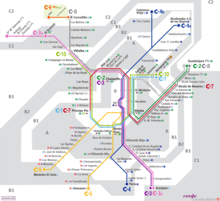| C-9 | |||
|---|---|---|---|
 Cercanías Line C-9 passing through Cercedilla | |||
| Overview | |||
| Status | Operational | ||
| Locale | Community of Madrid, Spain | ||
| Termini | |||
| Stations | 3 | ||
| Service | |||
| Type | Commuter rail | ||
| System | Cercanías Madrid | ||
| Operator(s) | Renfe Operadora | ||
| Rolling stock | RENFE Class 442[2] | ||
| History | |||
| Opened | 12 July 1923 | ||
| Technical | |||
| Line length | 18.2 km (11.3 mi) | ||
| Number of tracks | Single | ||
| Track gauge | 1,000 mm (3 ft 3+3⁄8 in) metre gauge | ||
| Electrification | 1.5kV DC[2] | ||
| |||
Line C-9, formerly known as the Guadarrama Electric Railway (Spanish: Ferrocarril Eléctrico del Guadarrama), is a narrow-gauge mountain railway incorporated into Madrid's Cercanías commuter rail network. The line is operated by Renfe Operadora and runs through the Guadarrama Mountains from Cercedilla, Madrid to Cotos Pass, Segovia.[3][4] Although classified as a commuter rail line, Line C-9 primarily serves the ski resorts at Cotos and Navacerrada Passes,[5] connecting with the rest of the commuter rail system with the Line C-8 at Cercedilla Station.[1] Line C-9 is the only metre-gauge railway among the Cercanías Madrid lines.[6]
History
The railway was first conceived in the 1910s as a means of connecting urban Madrid to the Guadarrama Mountains via the Navacerrada Pass. Construction began in 1919 and the section connecting Cercedilla on the Madrid-Segovia Line with Navacerrada opened on 12 July 1923 as the Guadarrama Electric Railway.[7][8] The opening was attended by the King and Queen of Spain. The line was originally electrified at 1000 V dc.[9] Service was interrupted during the Spanish Civil War but resumed in 1940. In 1954, the line was acquired by the state-controlled RENFE, the only metre gauge line to be operated by them. RENFE began constructing the extension to Cotos Pass in 1959. The section to Cotos, including a 671 m (2,201 ft) long tunnel through Navacerrada, was completed in 1964.[10]
From 1973 to 1975, the entire line was renovated and modernized and the line voltage increased to 1500 V dc.[9] The line was anticipated to continue through the mountains to Segovia, but this plan was abandoned. In 1990, the Guadarrama Electric Railway was incorporated into RENFE's commuter rail network, Cercanías Madrid, and renamed Line C-9. The portion of the line between Navacerrada and Cotos was closed from 2011 to 2012 to undergo renovations.[11]
Rolling stock

The original Swiss built railcars ordered in 1922 remained in service until 1964. Initially there were two motor cars and two trailers with an extra motor car and two trailers being added in 1936. They were replaced by second hand SECN stock, nicknamed Navals, from other metre gauge lines, principally from the Ferrocarill de la Loma. These were six motor cars, numbered 3006–3011, and two trailers, numbered 6011–6012.[7] They were later classified by RENFE as Class 431. The brakes on these units proved insufficient for the steeply graded sections of the line with one unit running away approaching Cercedilla, being brought under control just in time. They were gradually replaced by MTM Class 442 units between 1976 and 1982.[9]
In 1967 the line acquired a Stadler diesel shunter, fitted with a rotary snowplough, for engineering use on the line. Initially numbered 111 it was renumbered 300-111-2.[7]
Preservation
The original Swiss railcar, CN1, is preserved at Cercedilla. A railcar and trailer, CN2 and CNR1, have been preserved at the railway museum in Madrid.[7]
Route
Line C-9's 18.2 km (11.3 mi) route begins at Cercedilla Station on the Madrid-Segovia railway line,[1] approximately 45 km (28 mi) northwest of Madrid. From this station at an altitude of approximately 1,150 m (3,770 ft) above sea level, the line slowly climbs up the southern slopes of Siete Picos through Fuenfría Valley until it reaches Navacerrada Pass Station at an altitude 1,765 m (5,791 ft). From here, the railway line crosses the drainage divide of the Guadarrama Mountains and enters Valsaín Valley in Segovia Province. After a gradual climb, the line reaches its terminus of Cotos Station with a peak elevation of 1,819 m (5,968 ft) above sea level.[10] The total gain in elevation of the line is 719 m (2,359 ft).
Stations

| Station | Cercanías Madrid transfers | Municipality | Fare zone |
|---|---|---|---|
| Cercedilla | C-8 | Cercedilla | |
| Puerto de Navacerrada | - | ||
| Cotos | - | Real Sitio de San Ildefonso |
Gallery
-
Route terminus in Cercedilla
-
Navacerrada Pass Station
-
Line C-9 passing through pine forest below Siete Picos
References
- ^ a b c "Estaciones y Líneas". Cercanías Madrid. Renfe. Retrieved 2019-12-29.
- ^ a b "Línia Cercedilla - Cotos". Trenscat (in Spanish). Retrieved 2019-11-19.
- ^ "Cercanías Madrid". www.renfe.com (in Spanish). Retrieved 2017-12-04.
- ^ "Línea C9. Cercanías Madrid Renfe. Cercedilla - Cotos". madrid.es (in Spanish). Retrieved 2017-12-04.
- ^ Macrae, Helen (2015-01-18). "LET'S HIT THE SLOPES! SKI AND SNOWBOARD IN MADRID". Naked Madrid. Retrieved 2019-12-09.
- ^ Time Out Madrid. Time Out Guides. 2001. p. 277. ISBN 9781846702976.
- ^ a b c d Morley, J; Spencer, P G (1995). Locomotives and Railcars of the Spanish Narrow Gauge Public Railways. London: Industrial Railway Society. pp. 46–47, 115. ISBN 0 901096 88-1.
- ^ "Ferrocarril Eléctrico de Cercedilla al Puerto de Guadarrama (Navacerrada)". Ferrocarriles de España (in Spanish). 2012-05-06. Retrieved 2019-11-19.
- ^ a b c Rowe, D Trevor (1995). Narrow Gauge Railways of Spain Vol 2. Brighton: Plateway Press. p. 11. ISBN 1 871980 25 9.
- ^ a b "El Ferrocarril Eléctrico del Guadarrama (y XIII)". Historias matritenses (in Spanish). 2013-12-05. Retrieved 2019-11-19.
- ^ "La línea C-9 de Cercanías entre Cercedilla y Cotos retoma su servicio habitual a partir del día 17" (in Spanish). Europa Press. 2012-06-11. Retrieved 2019-11-19.












